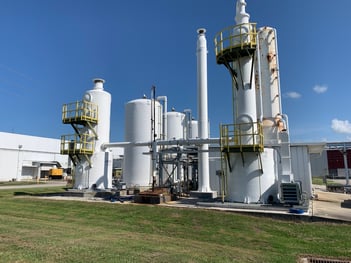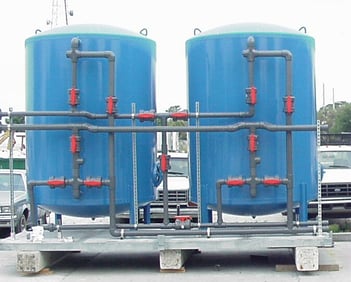 Degasification and decarbonation are essential processes in water treatment that play a crucial role in improving water quality.
Degasification and decarbonation are essential processes in water treatment that play a crucial role in improving water quality.
These techniques focus on removing dissolved gases, such as carbon dioxide and hydrogen sulfide, from water sources. By effectively expelling these gases, the overall water treatment process becomes more efficient and reliable.
Decarbonation: Reducing Carbon Dioxide Levels
Decarbonation specifically focuses on reducing the amount of carbon dioxide present in water. Excessive carbon dioxide not only affects the pH but also impacts the taste, odor, and overall quality of the water.
Decarbonation techniques can improve the aesthetics and taste of water. This results in purified and refreshing water for consumption. Water filtration systems are an effective way to enhance water purity.
Water filtration systems complement degasification and decarbonation processes by further enhancing water quality. Reverse osmosis is a widely used technique.
It uses a semi-permeable membrane to remove dissolved impurities, such as carbon dioxide and other contaminants. This process effectively filters water, producing purified and safe drinking water.
Different Types of Water and Filtration Systems
Various types of water require specific filtration approaches. Alkaline water, for instance, often undergoes filtration processes to remove impurities and balance its pH.
Water systems that use water filtration can offer alkaline water. This water has a better taste and may have health benefits. It is important to monitor dissolved gas levels, which are measured in parts per million (ppm).
To ensure optimal water quality, monitoring the levels of dissolved gases is crucial. Dissolved gas levels, including carbon dioxide and oxygen, are measured in parts per million (ppm). Water treatment facilities use advanced testing methods to measure the ppm of dissolved gases. This helps them decide which degasification and decarbonation processes to use.
Degasification is a process used to remove dissolved gases, primarily carbon dioxide and oxygen, from water. Carbon dioxide is a gas that dissolves in water and can form carbonic acid, changing the pH of the water. When the pH of the water is altered, it can lead to corrosion and other issues.
 Techniques and technologies can be used to remove carbon dioxide and oxygen from water.
Techniques and technologies can be used to remove carbon dioxide and oxygen from water.
These include air stripping, vacuum degasification, and membrane degasification.
Air stripping involves passing air through the water, and removing gases through the release of bubbles. Vacuum degasification utilizes a vacuum to draw out dissolved gases, while membrane degasification uses a membrane to filter out the solids.
Removing gases from water can have several benefits. It can reduce corrosion, improve water quality, and make it safe for use. Expelling dissolved gas from water can help to reduce corrosion. It can also improve water quality and ensure the water is safe for use.
Oxygen, on the other hand, can cause oxidation and affect the quality of treated water. By eliminating these gases, degasification ensures the stability and integrity of the water supply.
Decarbonation, on the other hand, focuses specifically on removing carbon dioxide from water. High levels of carbon dioxide can have an effect on water. It can affect the pH, taste, odor, and overall quality. Decarbonation techniques effectively reduce carbon dioxide levels, resulting in improved water aesthetics and taste.
A degasification system is a popular way to degasify and decarbonate. It usually uses technologies such as reverse osmosis and carbon absorption. Reverse osmosis uses a semi-permeable membrane to eliminate dissolved gases. Activated carbon is used in carbon absorption to capture and trap calcium carbonate and then the use of a degasifier (Or Decarbonator) removes the dissolved CO2 gases.
The efficiency of degasification and decarbonation processes depends on several factors. These include the surface area available for gas exchange, the pH of the water, and the temperature. Proper adjustment of pH is crucial to maximize the removal of dissolved gases. It is recommended to maintain a pH level within the ideal range to ensure optimal degasification and decarbonation efficiency.
Implementing degasification and decarbonation techniques in water treatment systems offers numerous benefits. Firstly, it enhances the overall water quality, ensuring it meets the required standards for consumption, industrial use, or environmental discharge. It reduces the risk of corrosion and fouling in pipelines and equipment. This leads to improved operational efficiency and lower maintenance costs.
Degasification and decarbonation are essential in water treatment processes. Their purpose is to eliminate gases like carbon dioxide and hydrogen sulfide that are dissolved in the water.
In conclusion, these steps are important for successful water treatment.
These techniques contribute to the improvement of water quality, mitigating potential issues caused by these gases. Water treatment facilities and wastewater treatment plants can improve the quality of water through efficient degasification and decarbonation systems. This ensures safe, reliable, and high-quality water for a variety of applications.
For information on degasification and decarbonation techniques, their benefits, and related technologies, visit reputable sources such as Science Direct and WaterProfessionals.
If you need more information, contact the professionals at DeLoach Industries at 941-371-4995. They can answer any questions you may have.




